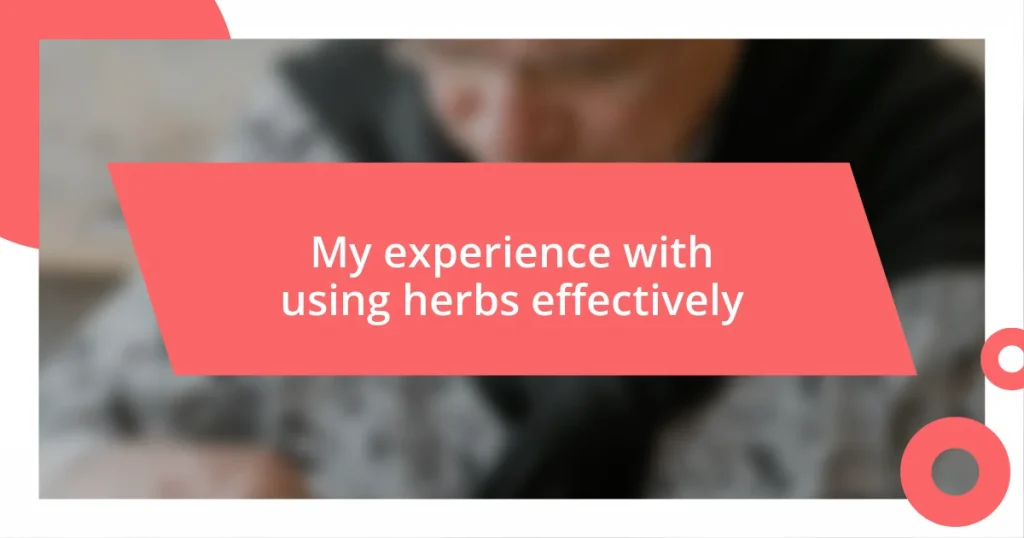Key takeaways:
- Herbs provide natural healing properties and emotional connections, enhancing both culinary experiences and overall well-being.
- Selecting the right herbs involves understanding their uses, growing conditions, and starting with versatile options like basil, mint, and rosemary.
- Effective herbal usage includes starting with small quantities, sourcing fresh herbs, and experimenting with combinations for delightful flavors.
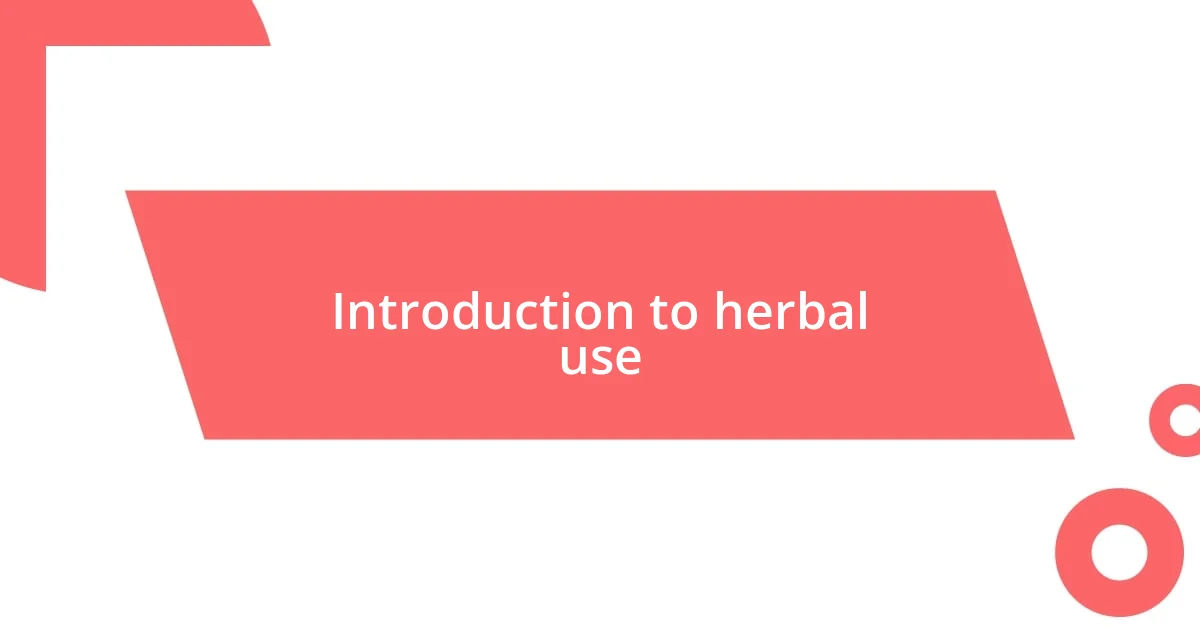
Introduction to herbal use
Herbs have been a part of human culture for thousands of years, often regarded as nature’s medicine. I remember my first encounter with herbal remedies; it was a rainy afternoon when a friend introduced me to chamomile tea. That moment opened a door to a world of natural healing that felt truly empowering.
Using herbs is not just about remedies; it’s about connecting with nature and nourishing our bodies holistically. Have you ever taken a quiet moment to appreciate the fragrant aroma of fresh basil or rosemary? I find that engaging with herbs deepens my appreciation for their healing properties and makes the process feel almost ritualistic.
What I love about herbal use is its accessibility. You don’t have to be an expert to begin this journey; a simple trip to your kitchen can lead to countless possibilities. When I started growing my herbs at home, I felt a sense of achievement that enhanced my cooking and my health. The act of nurturing those plants brought a sense of calm and purpose to my life, which I believe everyone deserves to experience.
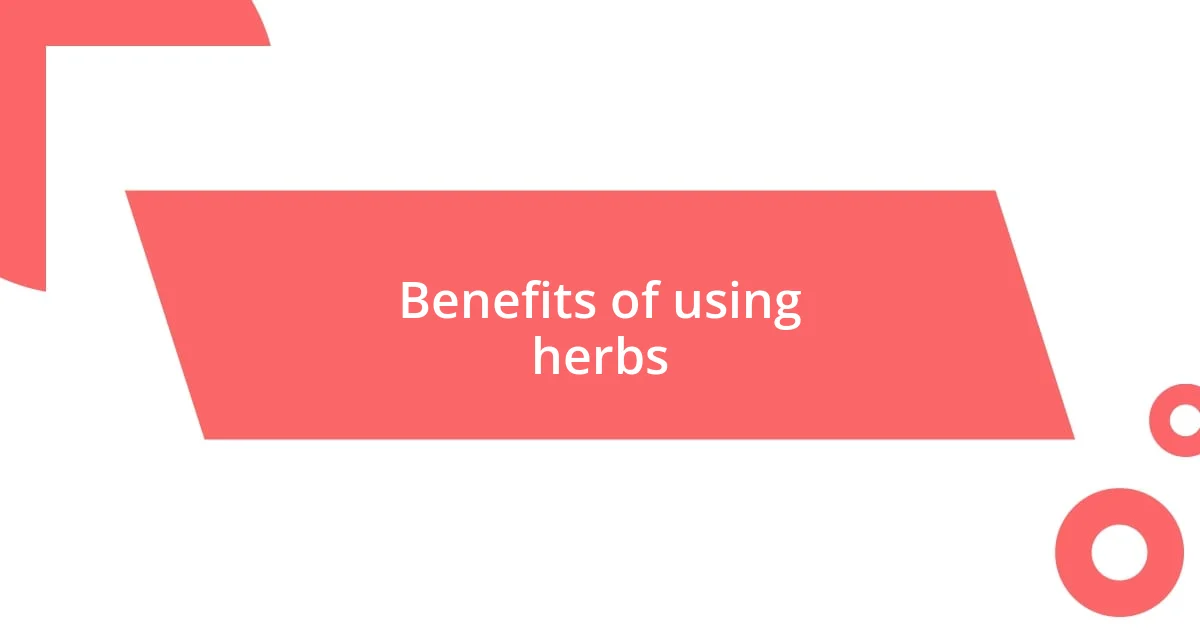
Benefits of using herbs
Herbs offer a multitude of benefits that go beyond just flavoring our food; they can also enhance our overall well-being. I’ve noticed how incorporating herbs like ginger into my diet not only spices up my meals but also aids in digestion and boosts my immune system. The experience of crafting a soothing herbal infusion, filled with calming ingredients like lemon balm or lavender, becomes a moment of self-care that can’t be replicated by packaged remedies.
Here are some notable benefits of using herbs:
- Natural healing properties: Many herbs contain compounds that can alleviate symptoms and promote health, such as anti-inflammatory effects from turmeric.
- Enhanced flavor: Herbs make meals not only healthier but more enjoyable, transforming a mundane dish into something vibrant.
- Emotional connection: Tending to herbs can ground me; it instills a sense of mindfulness, whether I’m snipping fresh mint for my tea or using parsley to garnish a dish.
- Accessibility: Most herbs can be easily grown in your kitchen garden, making them a convenient resource for anyone, regardless of their gardening experience.
- Boosted creativity: Experimenting with herbs encourages me to explore different cuisines and flavors, which can reignite my passion for cooking.
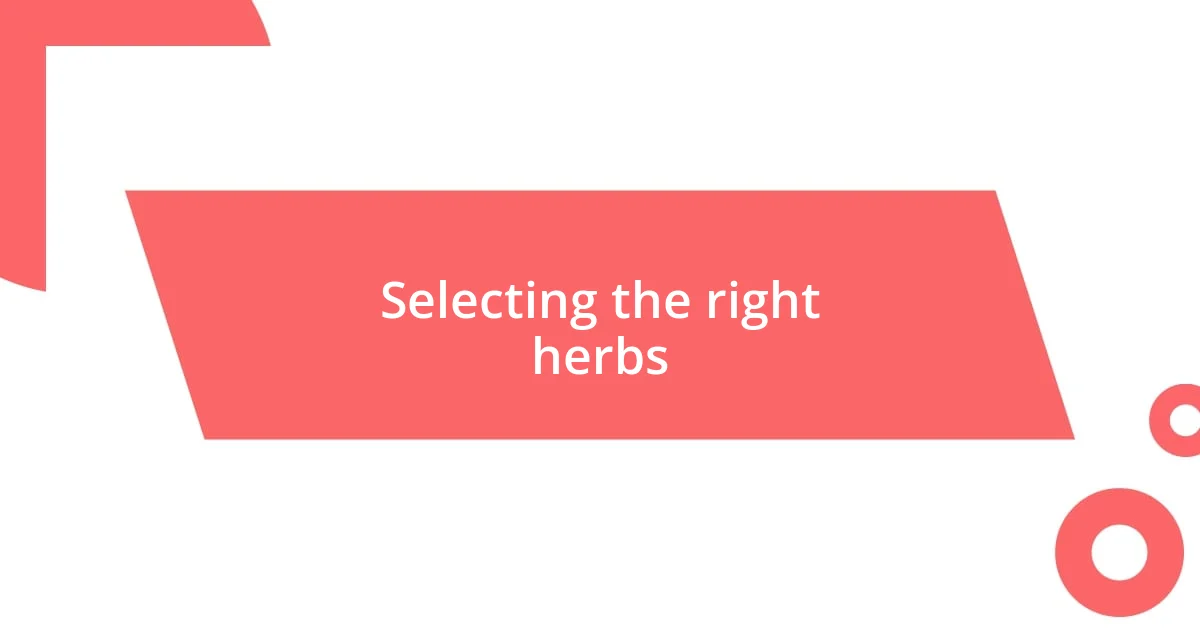
Selecting the right herbs
Selecting the right herbs can feel overwhelming at first, but I’ve learned that a little familiarity goes a long way. Start by considering the purpose you have in mind—are you looking for culinary ingredients or remedies? I remember when I chose to grow oregano for my pasta dishes; its robust flavor has become a staple in my cooking. By reflecting on what you want from herbs, you can narrow down your choices and make a more informed selection.
It’s also essential to pay attention to the growing conditions for each herb. For instance, some herbs thrive in sunny spots while others prefer shade. I once placed my cilantro in a hot, sunny area, only to watch it wilt quickly. Understanding the needs of the herbs you select can significantly influence your success in using them effectively in your daily life.
Lastly, consider starting with a few versatile herbs that can be employed in various dishes or uses. Basil, mint, and rosemary have proven to be invaluable in my kitchen and home remedy practices. I’ve found that having these on hand makes it easier to experiment with flavors and health benefits, leading to an enriching experience that makes cooking feel spontaneous and delightful.
| Herb | Primary Use |
|---|---|
| Basil | Culinary (pasta, salads) |
| Mint | Digestive aid, teas |
| Rosemary | Culinary (roasts, infusions) |
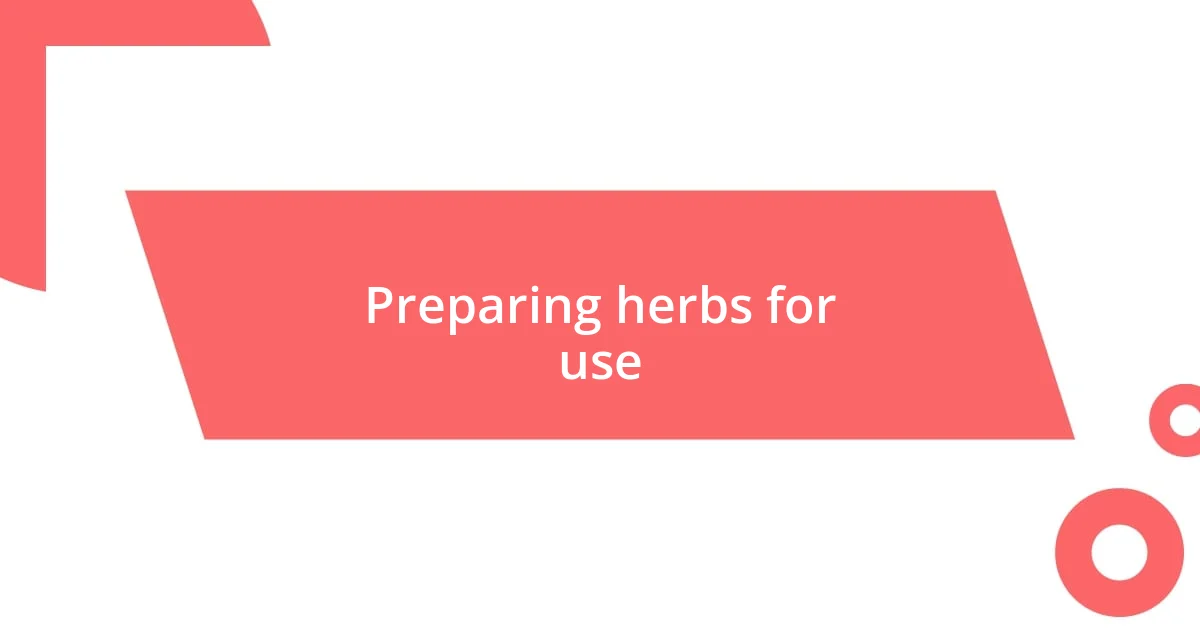
Preparing herbs for use
Preparing herbs for use is an enriching experience that I cherish. For me, the journey begins with washing fresh herbs under cool water to remove any residual dirt. It’s a simple act, yet it feels like I’m reviving the plant, bringing its vibrant essence closer to the forefront of my cooking. Have you ever noticed how a quick rinse can really enhance the aroma? I find that herbs seem to release their fragrances more fully once they’re clean and ready for action.
After washing, I like to chop or tear the herbs, depending on what I’m making. When I chop basil, I try to slice it gently, preserving its fragrant oils. I remember the first time I made pesto and smelled that fresh basil being released with each chop—it was intoxicating! I often ask myself, “How can something so simple bring such joy and flavor?” The act of preparing the herbs transforms them into a key ingredient, capable of elevating a dish from ordinary to extraordinary.
Sometimes, I take the extra step of drying my herbs, especially when I have a surplus in the garden. I hang them upside down in a cool, dark place, which feels almost ceremonial. Looking at them slowly drying gives me a sense of accomplishment and anticipation. The change in texture and flavor once dried is remarkable; I can’t help but smile when I sprinkle dried thyme into a stew, recalling those sunny days spent in the garden. How about you? Have you tried drying your herbs to preserve that fresh taste for later use?
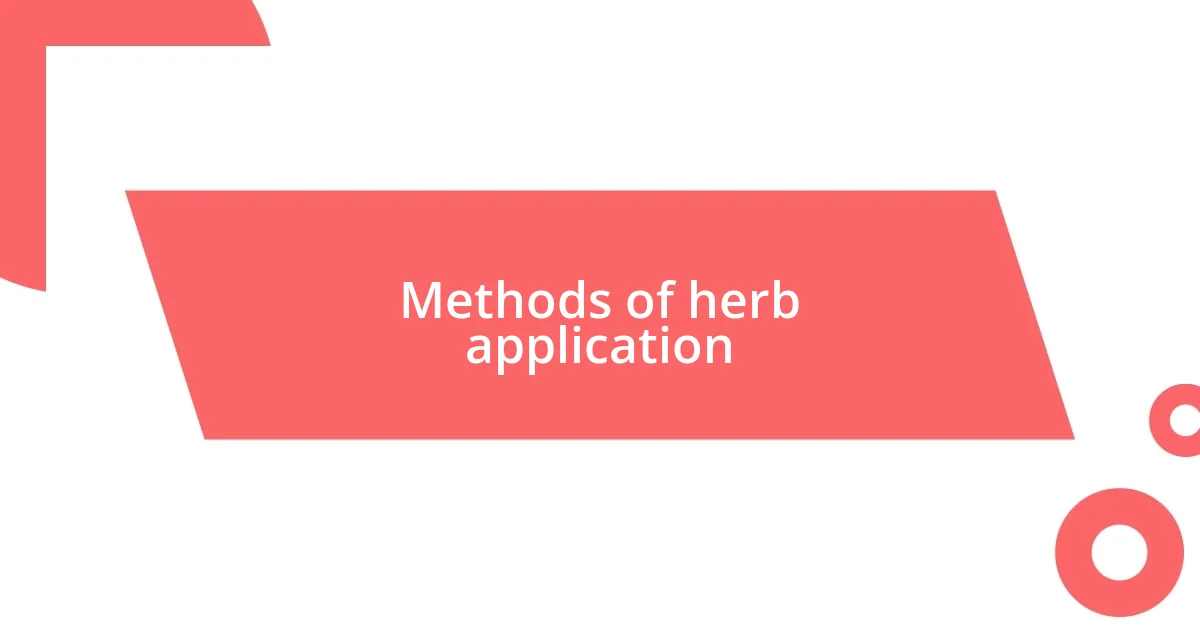
Methods of herb application
When it comes to applying herbs, I’ve discovered several methods that really enhance both flavor and health benefits. One of my favorites is steeping herbs in hot water to create herbal teas. I remember the first time I made a chamomile tea with dried flowers from my garden; the soothing aroma enveloped my kitchen, and it felt like a warm embrace after a long day. Have you ever made tea this way? It’s not only comforting but also a way to harness the calming properties of herbs.
Another method I frequently use is making herbal infusions, which can be transformative in cooking. For instance, I once infused olive oil with rosemary and garlic, and the result was simply divine. Pouring that golden oil over grilled vegetables made every bite a taste of paradise. I believe the process of infusion allows you to extract and concentrate the essence of the herbs, enhancing your dishes in an unexpected way. Have you experimented with infusions? If not, I highly recommend it—the depth of flavor it adds is often surprising.
For those feeling adventurous, I’ve dipped into creating herbal salves for topical use, which has been quite rewarding. My first attempt involved mixing dried calendula flowers with coconut oil, and I was amazed at how soothing it felt on minor scrapes and burns. It’s incredible to think that the same herbs that flavor our meals can also nurture our skin. What other versatile applications could you explore with herbs? Each method I try opens up a whole new world of possibilities, making my culinary and wellness journey all the more exciting.

Personal success stories
It’s fascinating to think about how using herbs has transformed my cooking. One particular memory stands out: I had a garden filled with fresh mint, and one summer evening, I whipped up a mint and yogurt sauce for grilled lamb. When I took my first taste, I was hit with this bright, refreshing flavor that was just electric! Have you ever tasted something so fresh that it brought you back to a moment in time? That dish not only made the meal memorable but also connected me to the effort I put into growing those herbs.
There was another time I experimented with herbal syrups. I had some leftover lavender from a batch of homemade soap, and I decided to turn it into a syrup. The sweet floral notes added a unique twist to lemonade, turning a simple drink into a stunning signature refreshment for a summer gathering. I remember watching my friends’ faces light up as they sipped it, and it filled me with pride to know that my creativity brought joy to others. Have you ever created something that unexpectedly delighted those around you?
I’ve also had great success with making herb-infused vinegars. One time, I combined thyme with apple cider vinegar and let it steep for a few weeks. When I finally tasted it, I was amazed at how the flavors melded together harmoniously. I couldn’t wait to drizzle it over a simple salad, and that tiny bit of extra effort made everything so much better. It’s those moments when the fruits of my labor shine a little brighter that remind me how powerful herbs can be in elevating not just dishes, but experiences. Would you be willing to give infused vinegars a try in your culinary adventures?
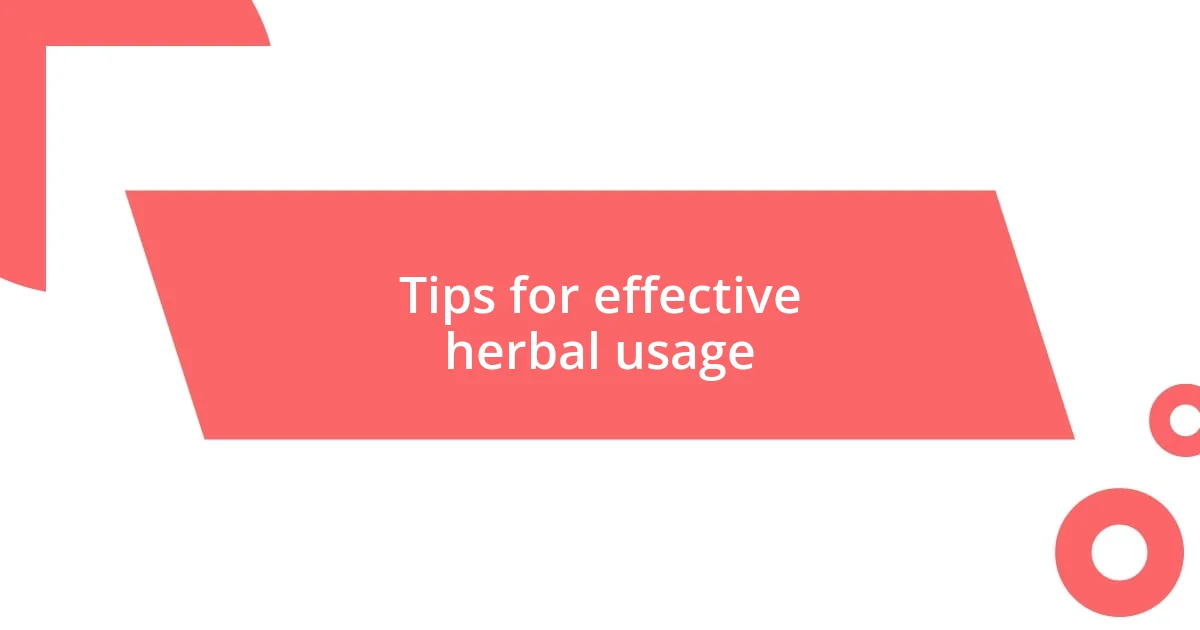
Tips for effective herbal usage
When using herbs, I’ve learned to start with small quantities and gradually increase them to find the perfect balance. I remember the first time I added too much basil to my pasta sauce; it overwhelmed the dish instead of enhancing it. Have you ever been tempted to throw in a handful of herbs only to regret it later? A pinch can be magical, while too much can muddle the flavors entirely.
Another tip is to source fresh herbs whenever possible, as their potency and flavor far surpass dried ones. I often find myself at local farmer’s markets, eagerly choosing vibrant sprigs of cilantro or parsley. The rush of those fresh scents invigorates me. I firmly believe that using fresh herbs not only boosts your culinary creations but also enriches your overall experience in the kitchen. Have you explored what’s available in your community? You might discover a new favorite herb!
Lastly, I’ve found that experimenting with different combinations of herbs can yield delightful surprises. For instance, I once stumbled upon a blend of sage and lemon zest that completely elevated my grilled fish. It was a beautiful interplay of earthy and bright flavors. Have you ever combined herbs in ways that surprised you? I encourage you to play with flavor profiles, as you never know what fantastic pairings await you in your pantry!










